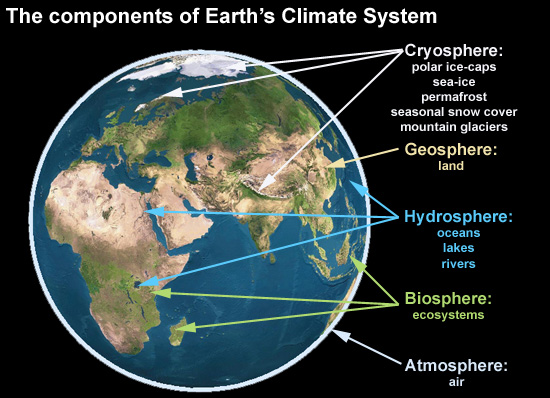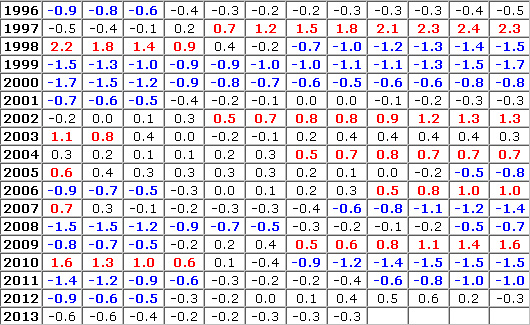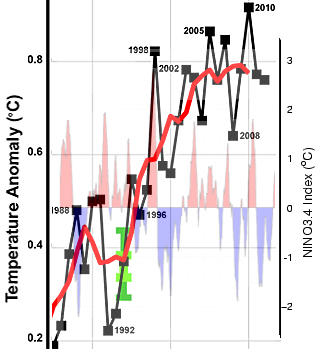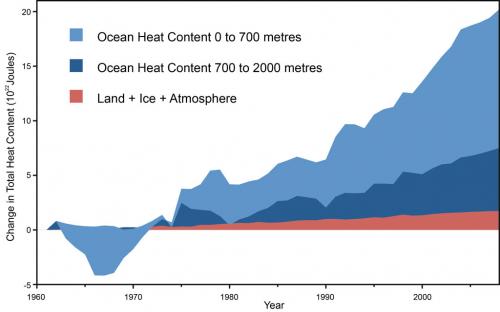
This is a basic primer on the components of Earth's climate and how and why they are important. It is aimed primarily at people who are relatively new to the subject and who wish to find out more.
Reading a lot of media coverage (and associated comments) with respect to the recently-released IPCC's AR5 Summary for Policymakers, it is apparent that some confusion is being generated over what exactly constitutes Earth's climate. Too frequently, whether by intent or by mistake, the term 'global warming' is only being applied to a subset of a single part of that system, namely the surface temperature record of Earth's atmosphere.
There's a lot more to the climate than that: it is a complex system with a number of key components - the atmosphere, the hydrosphere (oceans, lakes and rivers), the cryosphere (snow and ice), the geosphere (soils and rocks) and the biosphere (living things), all of which play important roles.
Living things act as sources and sinks for carbon. Snow and ice are of paramount importance in controlling the planet's albedo - the amount of sunlight that may be reflected straight back into space. They are in turn sensitive to both air and water temperatures. The oceans act as sinks and sources for both carbon and heat energy and are sensitive to atmospheric conditions overhead, and so on. The following graphic maps the key components out:

We will now go on to look at those individual components and how they interact. For ease of reading, let's take them in order of appearance on the graphic, from the top down.
The snow and ice on planet Earth consists of five subsets: the ice-caps, polar sea-ice, permafrost, mountain glaciers and seasonal snow-cover. Its biggest part is the gigantic ice-caps that sit atop Greenland and the Antarctic. These have both been losing mass in recent decades due to an accelaration of melting. Such melting makes a direct contribution to sea-level rise.
Next most important (in terms of size) is sea-ice, which because of its large changes in surface area during its seasonal melting and regrowing seasons is an important variable in terms of Earth's albedo. Sea-ice melt has no bearing on sea-level changes. However, increased seasonal melt opens more water to receiving and absorbing incoming solar radiation. In the Arctic, sea-ice area, extent and volume have all exhibited a significant downward trend. In the Antarctic, sea-ice has exhibited a weak upward trend, more as a function of changes to regional wind-patterns than any imagined cooling. It is important to note that the Arctic and Antarctic are geographical opposites in more than one way: the Arctic is an ocean surrounded by landmasses, whereas the Antarctic is a huge landmass surrounded by ocean. This difference has a considerable bearing on the factors that influence seasonal sea-ice behaviour.
The third subset is permafrost - permanently-frozen soil. Permafrost is important because it locks up a lot of trapped greenhouse gases like carbon dioxide and methane. However, it is becoming increasingly unstable in many areas: regionally-enhanced warming, such as that occurring in the Arctic and adjacent areas, is leading to permafrost melt, with accompanying release of the gases once they are able to make their way to the surface. The quantities of such gases at risk of release due to permafrost-melt are very substantial indeed.
Mountain glaciers are of prime climatological importance in terms of water-storage. Himalayan glaciers are particularly vital in such terms, providing a reliable source of river-water to the plains below. Mountain glaciers continue to retreat around the world, except for areas where the supply of what ends up as glacial ice - snow - is increasing to the extent that ice supply outdoes ice-loss.
Seasonal snow-cover and its extent/duration are important with respect to albedo, and the lesser its extent/shorter its duration, the longer the period during which the rocks/soils on which it falls can receive incoming solar radiation. The trend in both of these variables is downwards.
The subaerial surface of the planet acts as a sink for incoming ultraviolet solar energy and it re-radiates infra-red radiation as it warms up. Albedo is important here too: darker rocks absorb more UV and emit more IR - that's why black tarmac feels hot on a sunny summer's day. It is also an important carbon sink: carbon dioxide dissolved in rainwater reacts chemically with some of the minerals making up the rocks. Topography is important: mountain ranges force air up over them, cooling it as it rises and enhancing rainfall. Conversely, because of that enhanced rainfall, areas downwind of mountains receive dryer air and tend to experience drier climates.
Plate tectonics demonstrates how, like other aspects of the climate system, the geosphere is constantly on the move: however, compared to the other components, the movement is very slow indeed: a snail's pace is a lot quicker. However, the geosphere has periodic perturbations that may drastically effect the overall climate in the short term: foremost among these are volcanic eruptions. Volcanoes are one important non-manmade source of carbon dioxide, emitting anything up to 300 million tonnes of the gas per year. This sounds like a lot but when placed against manmade emissions - 30,000 million tonnes a year is our current contribution - it falls by the wayside. Nevertheless, further back in geological time there have been eruptions that were off-the-scale compared to anything in human history and these likely did have significant effects on the climate.
Major eruptions can, conversely, lead to cooling effects in the atmosphere due to the amount of dust and volcanic aerosols such as sulphur compounds that are blasted kilometres up into the air. Although sometimes severe in nature, such effects tend to be short-lived because gravity and rainfall bring most of the dust and aerosols back to the planet's surface within just a few years. By contrast, the greenhouse gas carbon dioxide stays up there much longer: once up there it takes a long time to get rid of it again. The reason is because the fastest carbon dioxide sink - plantlife - is also carbon-neutral; plants take it in but re-release it when they die and decompose, which is an effectively continual process, recycling a lot of carbon dioxide all the time. That leaves other major carbon dioxide sinks such as weathering of rocks and absorption by the oceans, which are much slower processes for a number of reasons. That slowness effectively creates a bottleneck in the system, which means that if we add the gas to the atmosphere faster than it can be taken back in then levels will go up, as they have done. It is important here to distinguish between this adjustment time - the time (centuries) that it takes for Earth systems to remove a major atmospheric carbon-spike (such as a manmade doubling) and the atmospheric residency time of your typical carbon dioxide molecule, which is approximately five years.
The oceans are where most of Earth's liquid water occurs and they constitute nearly 70% of Earth's surface. They are an important sink for carbon: they both absorb it directly from the atmosphere and indirectly via the weathering of rocks. Dissolved carbon in the shallower waters is reprecipitated as calcium carbonate, forming sea-shells, the skeletons of corals and so on. In deeper water, calcium carbonate becomes more soluble, and beyond a certain depth it dissolves quicker than it forms (the carbonate compensation depth).
Sea-water is weakly alkaline: on the pH scale of 0 (extremely acid) to 14 (extremely alkaline), with neutral being 7, it has a pH of just over 8. However, dissolution of excessive carbon dioxide in seawater interferes with its chemistry by reducing the pH. It is important to understand that only small such changes, if rapid in nature, can lead to major problems in marine ecosystems. This is simply because marine organisms that build their shells or exoskeletons from calcium carbonate that they obtain from seawater are adapted to do so in a relatively narrow pH range. Stray outside of that range and their ability to build is severely diminished. Such organisms form the foundations of marine food-chains: if their existence is compromised then so is the existence of a spectrum of higher predators, including fish. This is why ocean acidification, as it's called, is an issue that requires urgent attention.
The oceans, constantly moving due to currents, winds and tides, also absorb and transport heat around the planet: over 90% of the total global warming effect is taking place within them. Surface warming occurs via incoming solar radiation and from addition of warm water from rivers, sometimes an important factor, for example in the Russian Arctic where continent-crossing rivers transport heat northwards. As oceanic water warms it expands, thereby contributing to rising sea-levels.
In terms of heat energy, the oceans have long been regarded as having three layers: an upper one down to 700m, a lower one from 700-2000m and, beneath 2000m, the cold abyssal waters. The transport of heat energy between the upper and lower layers is a major factor in climate change. Vertical mixing of ocean-water can occur due to currents, down-and upwelling, storms/prevailing winds and, more locally, tides.
In some areas, particularly in the Southern Hemisphere, fluctuations in persistent weather-patterns lead to prolonged periods at times in which the surface waters of the upper layer are acting as an especially strong heat source or, alternatively, a heat sink. Thus, in the best-known example, in the Pacific Ocean, they can cause a strong atmospheric warming (El Nino) or cooling (La Nina) effect over periods of a year or more. These fluctuations are expressed numerically by the monthly Oceanic Nino Index (below, taken from NOAA's Climate Prediction Center datapage here): blue values are La Nina and red values El Nino, and a glance reveals that 1997-8 was the strongest El Nino in the last 18 years. Clicking on the NOAA link, with data back to 1950, shows that the only other years in which the value exceeded +2 were 1972 and 1982-3.

Over short timespans, the effects of such fluctuations are far greater than the long-term, multidecadal trend due to manmade greenhouse gas emissions, which is why the surface air temperature records have such a noisy appearance with lots of peaks and troughs. A super El Nino, such as the one in 1997-98, can increase the global average surface air temperature in just one year by more than ten times the warming rate caused by the addition of manmade greenhouse gases to the atmosphere. A big La Nina can have the equally drastic but opposite, cooling, effect.

This graphic (L) takes the recent (1985-2012) part of the GISS surface air temperature record (left-hand scale, available here), superimposed on the historical sea surface temperature index, (right-hand scale, available here). With the surface air temperature record, annual averages are marked by the black line: as can be seen it zigzags up and down wildly. That's why a 5-year running average (red line) sees the trend a bit better, although it's still quite wavy. A big part of that black zigzagging is due to those El Nino-La Nina fluctuations, which appear on the sea surface temperature index as pinkish upward spikes (El Nino) and purplish downward spikes (La Nina).
It is immediately clear that some of the warmest years, such as 1998, coincided with strong El Ninos, where massive heat-release from the ocean raised global surface air temperatures to values above the running average. Likewise, some of the coolest years, such as 2000 and 2008, coincided with prolonged La Ninas, where massive heat uptake by the ocean reduced global surface air temperatures to values below the running average. These are not, however, coincidences: there is a direct relationship between the state of the El Nino-La Nina ocean cycle and global surface air temperatures that makes a lot of noise on the air temperature record on a year-to-year basis.
Other factors appear in the graph too: the June 1991 mega-eruption of Mount Pinatubo had a strong global cooling effect for a few years, with recovery occurring by the middle of that decade. More prolonged than El Nino-La Nina fluctuations, it thereby affected the running average, too.
Note that any claim of a long 'plateau' in the surface air temperature record can only be accomplished if the exact start-date of 1998 is very deliberately chosen and the running average completely ignored. If you were dishonest, you could equally start with a very cool year, picking the 1992-2006 period, and 'show' that the warming trend is far steeper than we thought. Statistician and blogger Tamino has a good post on on such 'cherrypicking', as it's called, here. A shorter plateau is there in the running average, starting about eight years ago - a time far too short to have any meaning in climatological terms. Similar periods have occurred on many other occasions before. In addition, the graphic shows the predominance of the heat-absorbing La Nina in the post-2007 period. Many are wondering what the next really big El Nino will look like!
An important source and sink of greenhouse gases, especially carbon dioxide, water vapour and methane, the biosphere is the living bit of the planet and comprises all ecosystems from soils to forests, from coral-reefs to plankton-rich shallow waters. It also includes humanity, of course, and its industrial/resource-consuming activities. The biosphere has little role as a direct heat source or sink, but indirect effects due to its massive influences on greenhouse gas levels are of prime importance. Not for nothing have the world's forests - especially the great Amazon rain-forest - been called 'the lungs of the planet'. This is all down to photosynthesis - the absorption by green plants of carbon dioxide and their excretion of oxygen as a metabolic waste-product. Photosynthetic plants - from the lowliest blue-green algae up to the mightiest trees - are responsible for our planet's oxygenated atmosphere. This useful feature only developed around 2.4 billion years ago when two things had occurred - firstly an explosion in the numbers and diversity of cyanobacteria and secondly the filling of easily-available chemical sinks for free oxygen (such as soluble iron in sea-water getting oxidised to insoluble iron oxides). Once free oxygen began to accumulate in the atmosphere, the transition towards the composition of the air we breathe today was well underway.
The above (very) potted history is enough to demonstrate clearly how vital a healthy biosphere is for Mankind and that it should not simply be regarded as a resource that can be destroyed in the name of profit. Without the evolution of photosynthetic plantlife, none of us would be here today. Like other mammals, we are an integral part of the biosphere and we utterly rely on it for our existence. However, there are few points along the geological timescale where life itself has significantly altered the composition of Earth's atmosphere. One was the aforementioned oxygenation event. Another occurred during the Devonian and Carboniferous periods, 419-299 million years ago, a time during which land was firstly colonised by an abundance of diverse plantlife. This caused a major drawdown of atmospheric carbon dioxide, the levels of which up to that point were much greater. The third such episode is now underway: Mankind is digging up or pumping out the fossilised products (coal and oil) of that plantlife and burning it as an energy-source, thereby returning a lot of that carbon dioxide back to the atmosphere.
The well-mixed cocktail of gases that surrounds Earth's surface, extending upwards for several hundred kilometres. It is divided up into a number of layers, the lowest of which is the Troposphere, which is where most weather occurs. Containing getting on for 80% of the molecules that make up the atmosphere, it varies in thickness according to air temperature: thus in cold Polar regions it is less thick compared to the warm Tropics, where it can reach 17km in depth. At its top - the Tropopause - there is a massive temperature inversion: whilst it gets colder with altitude in the troposphere, it suddenly warms up at the Tropopause.
Above the Tropopause is the Stratosphere, a thick layer of rarefied air which extends up to about 50km above the surface. It contains about 20% of the molecules that make up the atmosphere: importantly these include a layer enriched in ozone, which blocks a lot (>90%) of harmful UV light from the Sun: without that ozone, life as we know it would not exist as it does. At the top of the Stratosphere, the Stratopause marks the boundary with the very cold, extremely rarefied Mesosphere. This is where most meteors burn up. Containing just 0.1% of the molecules in the atmosphere, it is a hostile place in which temperatures may be as low as -100C near the top - the Mesopause. The latter zone, only a few kilometres thick, marks the next boundary into the Thermosphere above, which is a deep (several hundred km), virtually airless layer, where satellites such as the International Space Station orbit the planet.
Constantly on the move - just as the oceans - the air making up the atmosphere transports heat, cold, moisture and clouds over the planet's surface. Major frontal zones between quasi-permanent warm and cold airmasses are marked by jetstreams along which active weather-systems develop. Heat and moisture are exchanged with all other components of the climate system. Warmer air carries more water-vapour available to condense and fall as rain; rain transfers heat directly to land, rivers and oceans: conversely, direct solar heating of land in favourable conditions causes warmed air to rise swiftly upwards, carrying with it moisture, to cause convective thunderstorms.
Clouds reflect incoming solar radiation from their white tops but conversely act as insulating blankets trapping in heat beneath them. Greenhouse gases (especially carbon dioxide and water-vapour) impede the escape of space-bound infra-red heat energy: without them, Earth would be a frozen ball of ice at its distance from the Sun. However, the steady increase in their concentrations due to the burning of the fossil fuels has caused what on human lifescales may appear to be a gradual increase in the global energy imbalance, but which is, in geological terms, extremely steep.
There is a very important point regarding energy entering the various mediums described above, which is how much that medium warms as a response. This is a measurable property, known as specific heat capacity. Specific heat capacity is defined as the quantity of energy required to raise the temperature of a fixed mass of any particular substance by one degree Celsius. It is measured in Joules/Kilogram° Celsius (J/Kg° C). A look at the values given below will show why copper-bottomed saucepans are popular - not only do they conduct well but they warm up quickly, and why heat energy going from the atmosphere into the oceans has a slower warming effect than heat energy going from the ocean into the atmosphere (such as occurs during a big El Nino). In fact, water has one of the highest specific heat capacity values of all:
| Substance | Specific Heat Capacity, J/Kg° C |
| Gold | 129 |
| Copper | 385 |
| Granite | 790 |
| Air (dry, at sea-level) | 1005 |
| Ice | 2090 |
| Sea water | 3999 |
| Water (at 20°C) | 4182 |
All components of the climate system are affected by the increase in the energy imbalance caused by rising greenhouse gas concentrations resulting from burning fossil fuels: rising atmospheric and oceanic temperatures, reductions in polar and glacial ice, thaw of ancient permafrost, migrations of species as their favoured climatic zones move polewards all being examples with a common cause. Therefore, it is unwise to just look at surface air temperatures when discussing global warming: they are just a part of the multi-component system that is Earth's warming climate. The graph below shows this very clearly:

above: graph from Nuccitelli et al. (2012) [PDF] showing the change in the total heat content of Earth's Climate System since 1960 in terms of its major components: the total land, atmosphere, and ice heating (red) from Church et al. (2011), and the ocean heating for the 0-700 meter layer (light blue) and the 700-2,000 meter layer (dark blue) from Levitus et al. (2012).
** post updated 08/10/2013 to take out the error regarding the 2010 El Nino, which was only moderate in nature and to revise/add some links regarding carbon sinks in the final paragraph of the Geosphere section.
*** updated 12/10/2013 - added graphic of the Oceanic Nino Index from NOAA.
Posted by John Mason on Monday, 7 October, 2013
 |
The Skeptical Science website by Skeptical Science is licensed under a Creative Commons Attribution 3.0 Unported License. |